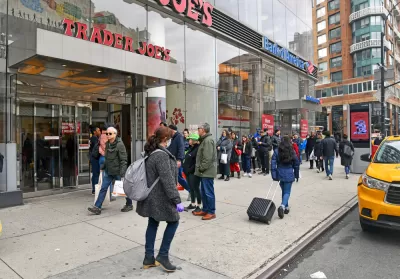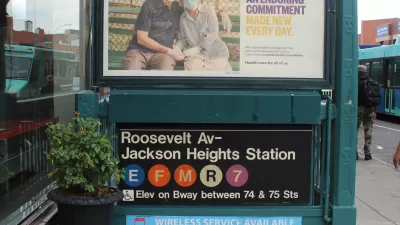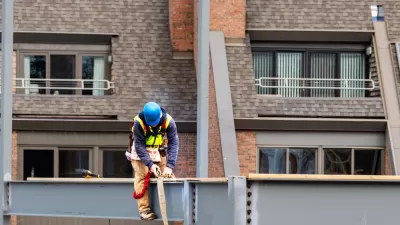Transit accessibility incentives are also included in a package of zoning reforms proposed this week that would provide incentives for grocery store developments in a wider swath of New York City.

Rebecca Baird-Remba reports on a bill proposed by New York City Mayor Bill de Blasio this week that would expand zoning incentives for grocery stores and transit station accessibility improvements, "allowing developers to get extra floor area in their buildings in exchange for including a supermarket or improving transit."
The grocery store incentives would expand the FRESH program, in place since 2009, to 11 new community districts, reports Baird-Remba.
"FRESH, which is an acronym for Food Retail Expansion to Support Health, allows developers to negotiate an additional 20,000 square feet of residential floor area in a new building in exchange for including a grocery store of at least 20,000 square feet," explains Baird-Remba.
The program has been controversial since its inception for a lack of progress in lower-income neighborhoods in the city.
"The Department of City Planning said that it plans to implement 'guidance' to prevent 'detrimental clustering of FRESH supermarkets' in gentrifying neighborhoods that have seen a significant amount of new residential development over the past decade," adds Baird-Remba. "The city also plans to waive up to 10,000 square feet of parking for a grocery store."
In addition to the grocery store improvements, Mayor de Blasio is also proposing a "Zoning for Accessibility" initiative that would allow developers additional floor area in exchange for funding accessibility improvements at the city's transit stations—a challenge that currently falls well below thresholds of accessibility established by state and federal accessibility laws.
FULL STORY: City Hall Expands Zoning Bonuses for Grocery Stores, Transit Improvements

Planetizen Federal Action Tracker
A weekly monitor of how Trump’s orders and actions are impacting planners and planning in America.

San Francisco's School District Spent $105M To Build Affordable Housing for Teachers — And That's Just the Beginning
SFUSD joins a growing list of school districts using their land holdings to address housing affordability challenges faced by their own employees.

The Tiny, Adorable $7,000 Car Turning Japan Onto EVs
The single seat Mibot charges from a regular plug as quickly as an iPad, and is about half the price of an average EV.

With Protected Lanes, 460% More People Commute by Bike
For those needing more ammo, more data proving what we already knew is here.

In More Metros Than You’d Think, Suburbs are Now More Expensive Than the City
If you're moving to the burbs to save on square footage, data shows you should think again.

The States Losing Rural Delivery Rooms at an Alarming Pace
In some states, as few as 9% of rural hospitals still deliver babies. As a result, rising pre-term births, no adequate pre-term care and "harrowing" close calls are a growing reality.
Urban Design for Planners 1: Software Tools
This six-course series explores essential urban design concepts using open source software and equips planners with the tools they need to participate fully in the urban design process.
Planning for Universal Design
Learn the tools for implementing Universal Design in planning regulations.
Smith Gee Studio
City of Charlotte
City of Camden Redevelopment Agency
City of Astoria
Transportation Research & Education Center (TREC) at Portland State University
US High Speed Rail Association
City of Camden Redevelopment Agency
Municipality of Princeton (NJ)





























